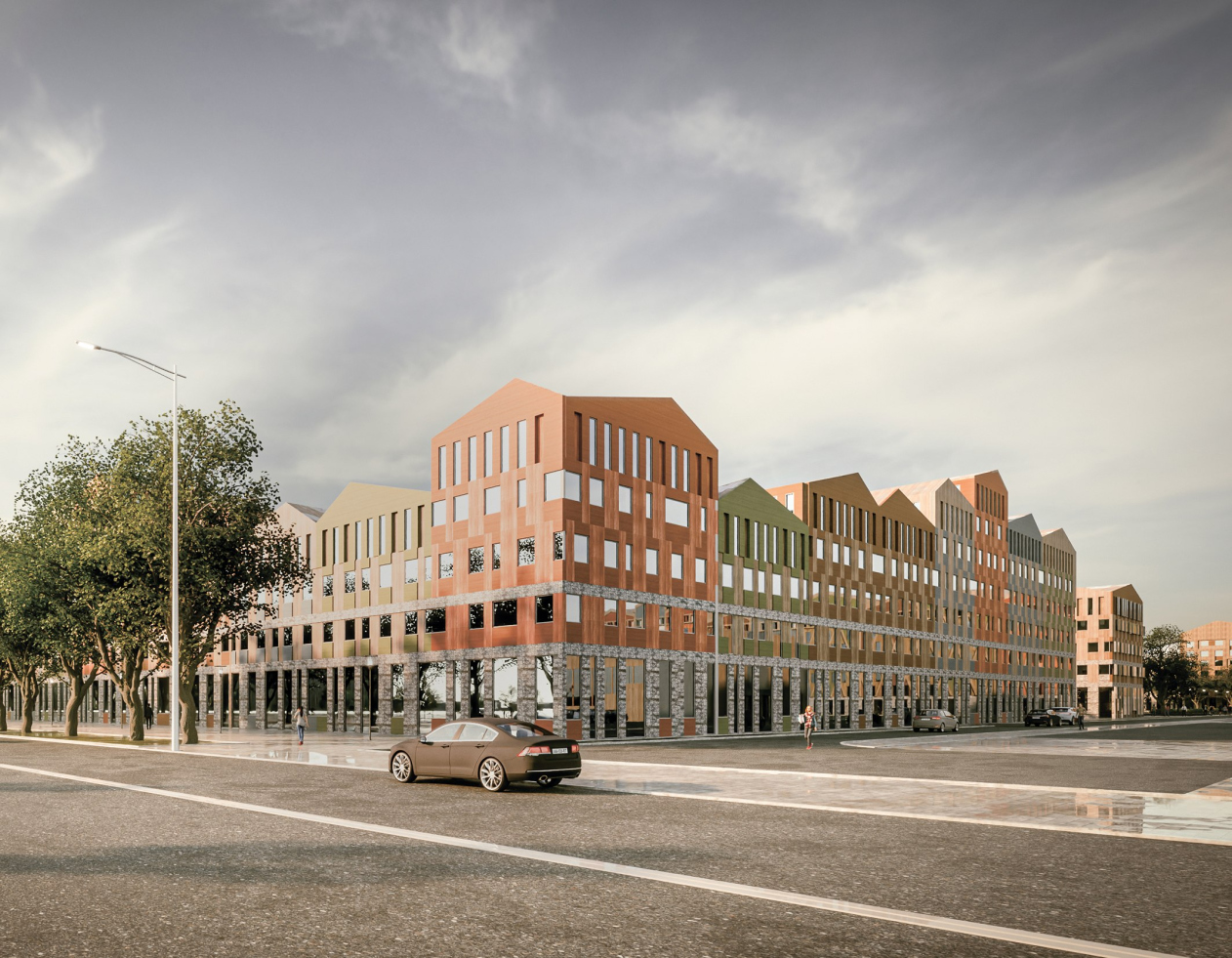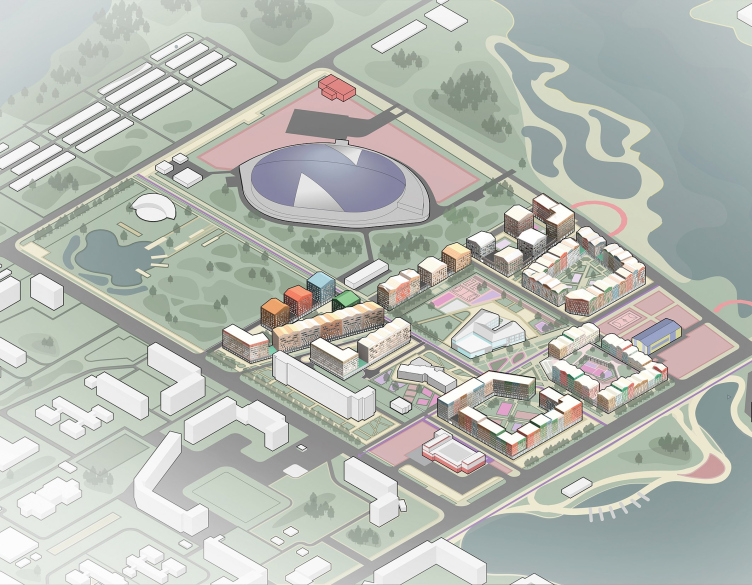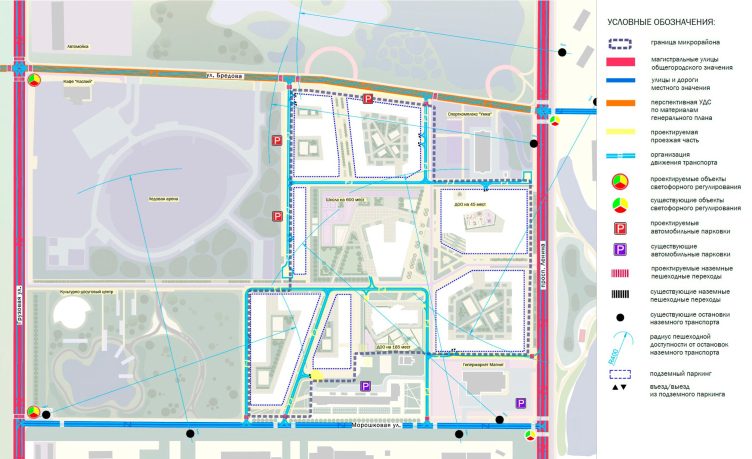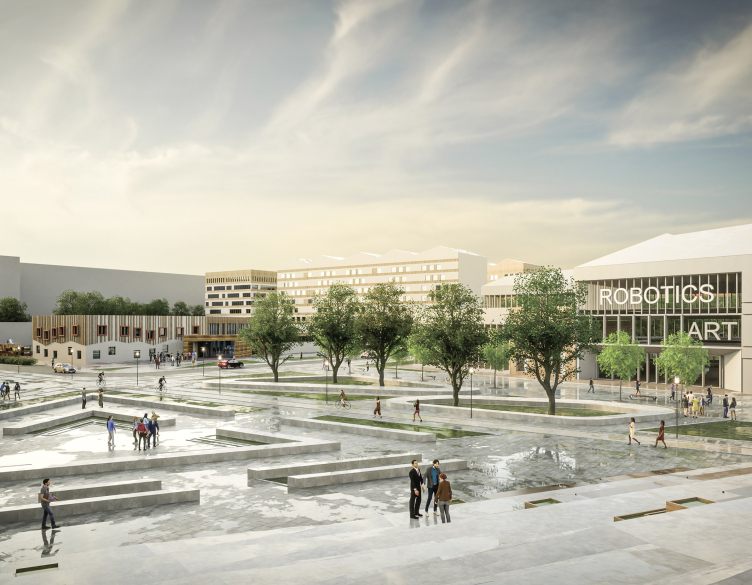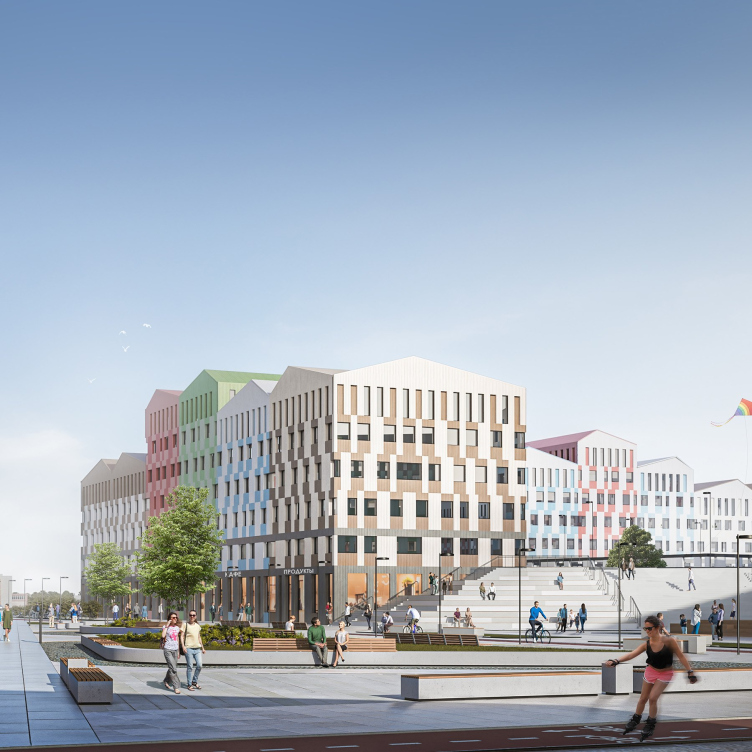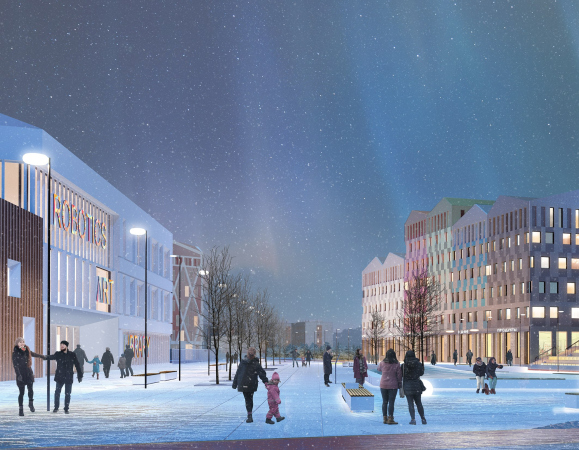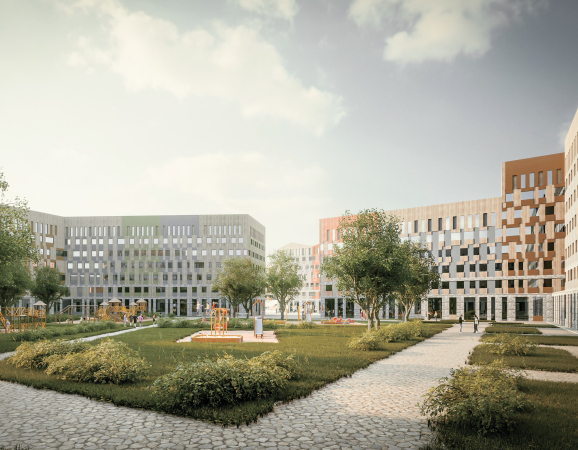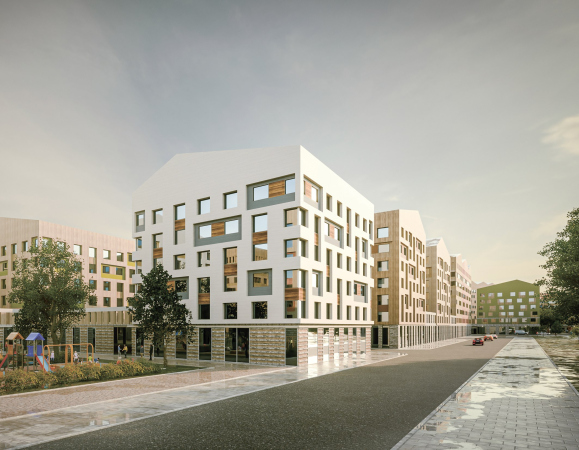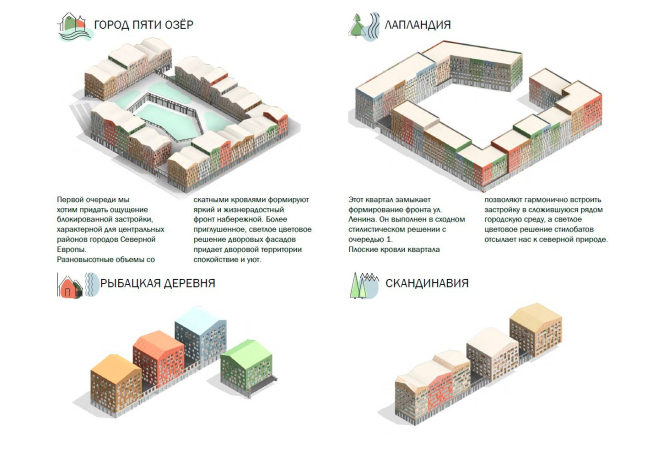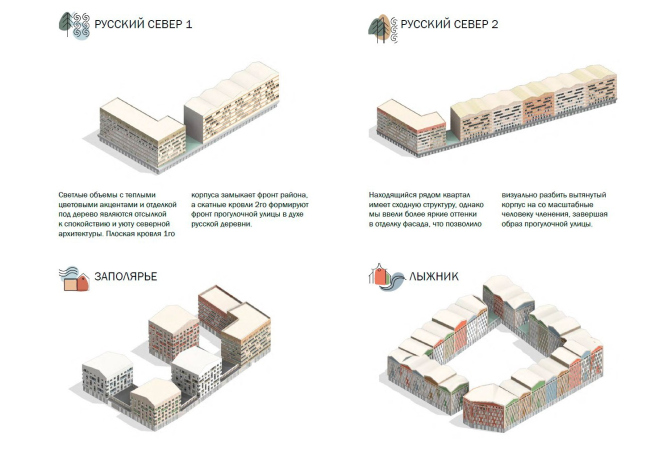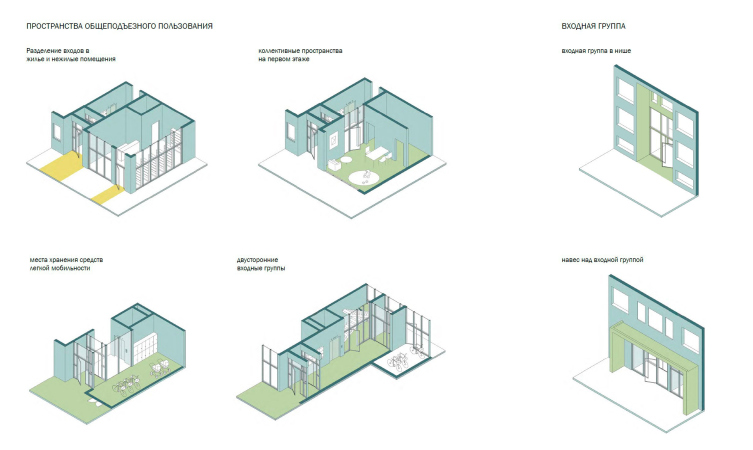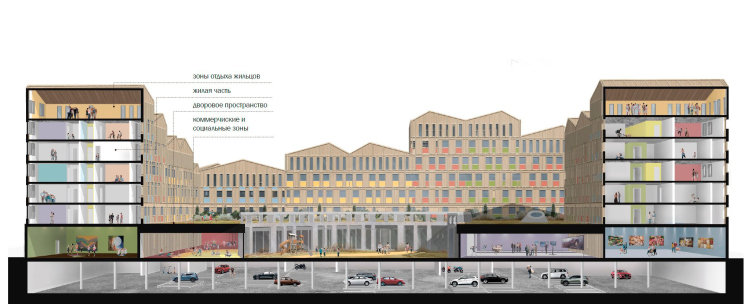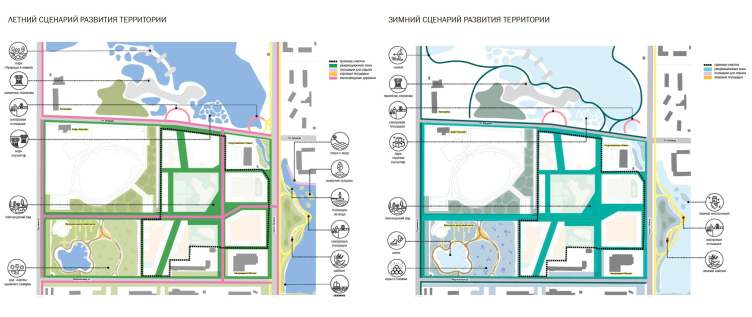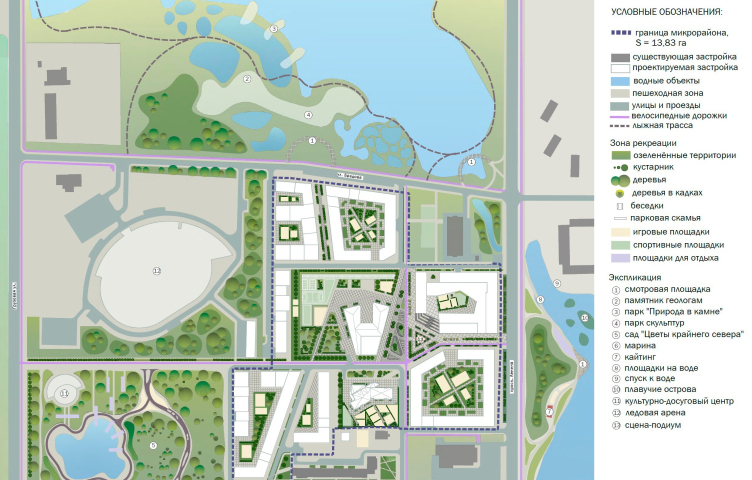To attract specialists for the new production facility, Nornickel plans to build housing of its own. Two years ago, a competition was held for the project. We told you about the competition quite a long time ago, and now we have an opportunity to take a closer look at the winning project – it has some interesting solutions in it. The authors of the project are a consortium of NIIPI Gradplan of Moscow, Dialectica (Spectrum Group) and the Dutch company Atelier PRO.
Metallurgists in the tundra
The name of the city comes from the Sami word “moncha”, which means “beautiful”, but this definition so far refers exclusively to the surrounding nature. Monchegorsk is located far above the Arctic Circle, between the Lapland Reserve and Lake Bolshaya Imandra, in the Monchetundra and Chunatundra mountain ranges. It is surrounded by hills and rocks, rivers and lakes.
Monchegorsk itself essentially consists of the Kola MMC, which occupies almost a third of the city, five-story Khrushchev-era buildings and wide streets blown through by an icy wind. There are also many water bodies within the city limits – lakes of various sizes and, again, the Moncha River. The neighborhood of the natural and man-made is reflected in the names of the streets: near Metallurgov Avenue and Nickel Highway there are Moroshkovaya (a kind of local berry) and Lesnaya (“Forest”) Streets.
The residential complex will occupy a plot of land that is now empty and divides the established neighborhoods. It is planned to build a cultural and leisure center and an ice arena in the same quarter – the city is very fond of sports. There are a lot of trees growing on the site; on three sides it is surrounded by water bodies, which gives ample opportunities for the arrangement of recreational areas. If all the projects are implemented, the site will claim the status of a central location, including in terms of concentration of public functions – which will be the right thing, as it is located in the layout center of Monchegorsk.
Each consortium member had its own tasks. NIIPI Gradplan was in charge of territory planning, while Dialectica, together with Atelier PRO, was responsible for the master plan and architecture. Spectrum Group, of which Dialectica is a part, helped with the structural design, soil studies, insolation and the “wind blowing” factor, which played a role in the jury’s choice of this project. It takes into account the main “challenges” of the city: icy winds, monotonous buildings and lack of public spaces.
Against the wind
One of the significant factors that influenced the layout of the neighborhood was the wind, which affects the residents of Monchegorsk. Because of this, the authors immediately turned to perimeter development and placed a kindergarten and a school in the center of the future micro-district, thus creating an area protected from the wind and endowed with urban significance: the school is planned to be used as a community center during extracurricular hours, and events for children and adults will be held there.
Luckily, there are no through streets where the wind could pick up any serious speed, the air flows are crushed by the frontal buildings of the outer perimeter, while inside they are separated and regulated by stylobates. On the other hand, it was necessary not only to protect the interior spaces from the wind, but also to ensure constant ventilation: since, as we remember, the ecological situation in the city is still far from ideal, it is important to avoid stagnation of industrial emissions. For ventilation, air corridors were provided, which are planned to be formed with the help of natural terrain, minor architectural objects, and green spaces.
After all the preliminary calculations – and this is where it gets interesting – modern technologies were involved: Spectrum Group “blew” the layout options in the Ansys software environment until it calmed down the air flows in all pedestrian spaces and courtyards. The calculations also involved the insolation factor – the architects started by making a “shadow map” of the city, which helped them to determine the best location of residential facades and playgrounds; parking lots and covered pavilions were also placed on shaded areas.
Our task was to offer a comfortable and compact urban environment, designed for pedestrian accessibility of services and social infrastructure, with a highly developed system of public spaces, and with a recognizable urban silhouette and eye-catching highlights. At the same time, we had to take into account the specifics of the climate and environmental situation, minimize the negative aspects, and enhance the positive ones. This approach will create a synergetic effect that can attract potential new residents and reduce population decline. Calculations to increase the economic potential of territories are one of the important skills of the consortium’s specialists.
I think our solution could become an example of developing Arctic single-industry towns according to the methodology of reducing the impact of harsh climatic conditions – and at the same time designing a modern image.
I think our solution could become an example of developing Arctic single-industry towns according to the methodology of reducing the impact of harsh climatic conditions – and at the same time designing a modern image.
The architects also took into account the landscape features, height differences and existing surroundings – primarily the Umka sports complex to the north of the site and the Magnit supermarket to the south.
Architectural and urban planning concept of a micro-district in Monchegorsk. Axonometry of the project proposal
Copyright: © NIIPI Gradplan of Moscow, Dialectica Spectrum, Atelier PRO
Architectural and urban planning concept of a micro-district in Monchegorsk. Scheme of transportation service of the territory
Copyright: © NIIPI Gradplan of Moscow, Dialectica Spectrum, Atelier PRO
The houses are grouped into several residential clusters that form the outer contour of streets, large courtyards and a system of internal public spaces – streets, little parks, sports facilities, and playgrounds. The heart of the neighborhood is a spacious central square next to the school and kindergarten, a place for meetings and celebrations, as well as lessons or exercising in the fresh air. Another preschool facility is “hiding” in the stylobate of the corner block, the center of which is “carved out” to host a playground. An amphitheater staircase leads here, oriented towards the main square.
Architectural and urban planning concept of a micro-district in Monchegorsk.
Copyright: © NIIPI Gradplan of Moscow, Dialectica Spectrum, Atelier PRO
Architectural and urban planning concept of a micro-district in Monchegorsk.
Copyright: © NIIPI Gradplan of Moscow, Dialectica Spectrum, Atelier PRO
Against the grayness
Another peculiarity of Monchegorsk is the monotonous uniformity of the existing buildings, which is further aggravated by overcast weather and polar night. For this reason, the authors turned to the idea of colored sections of houses: by changing the height, configuration and finish of the facades, as well as the coloristic solution, it is possible to mitigate the perceived scale and come to the desired diversity of the environment. In another place, the “gingerbread-like” quality of some angles might seem excessive, but the garishness is offset here by monochrome inclusions and the structure common to all the neighborhoods: there is a first floor gallery, there are variations for the “body” of the building, and there is an increased height of the last floor with a usually pitched roof. And in general, in Monchegorsk, where gray prevails on the streets, the eye wants to rest on something colorful.
Each residential cluster – there are seven of them in total – received its own reception and name. For example, “City of Five Lakes” is characterized by houses with pitched roofs and two-level courtyard space; “Russian North” has predominantly light-colored finishes with wooden accents.
“Fishermen’s Village” and “Scandinavia” are not enclosed in a block, but consist of separate sections resting on a stylobate – each has a color of its own; the houses are placed at bigger intervals, as they are closer to green areas.
When selecting shades, the architects were inspired by the nature of the Kola Peninsula: combinations of warm shades of forests, moss, dried grass and cold shades of rocks and lakes, emphasizing the contrast of warm and cold.
The diversity of houses will also affect the apartment layouts. The climate does not allow adding front gardens to the first floors, but the upper floors have higher ceilings and mezzanine apartments. In total, there will be about 2000 apartments in the new microdistrict, the range of their typology proposed in the project is designed for different social groups.
Against boredom
Not only in Monchegorsk, but also in any small town, it can be difficult to find an alternative to going to the store as a leisure activity, so it was important to offer people different scenarios. As already mentioned, an ice arena is planned on the territory of the neighborhood, the Umka Sports and Recreation Center with a swimming pool is also located nearby, and the architects tried to satisfy other demands.
Architectural and urban planning concept of a micro-district in Monchegorsk. The basic section view of the first phase
Copyright: © NIIPI Gradplan of Moscow, Dialectica Spectrum, Atelier PRO
The entire area between the houses works as a public space: human-scale pedestrian shopping streets lead to a public garden or square. Commercial spaces are planned in the first floors: cafes, stores, pharmacies, beauty salons, bank branches, as well as a children’s medical center, co-working space, media center, social and sports clubs. Since all residents of the neighborhood will work at the same enterprise and most likely will have common interests, it was necessary to provide a place for informal, yet at the same time corporate communication.
The community center located in the stylobate of the residential cluster of the first stage of the City of Five Lakes became such a place. Its space is aimed at residents of the new district, but it will also be open to all residents of Monchegorsk. The community center is complemented by mini-zones for residents to socialize: somewhere they are located in the stylobates, and sometimes in the upper floors, the very ones with high ceilings.
Architectural and urban planning concept of a micro-district in Monchegorsk. Scenarios of territory development
Copyright: © NIIPI Gradplan of Moscow, Dialectica Spectrum, Atelier PRO
Improvement of the territory around the neighborhood will give the residents of the city an opportunity to take long walks, do sports and contemplate the discreet but expressive nature of the Polar region. In the north and east, where the houses are adjacent to water bodies, a natural park with observation platforms, approaches to the water and infrastructure for active recreation on the water is proposed, such as a kite station, which, thanks to the wind and snow cover, can operate all year round. The cultural and leisure center will be complemented by a garden with flowers of the far north and a pond that turns into a skating rink in winter. A bicycle path runs through the network of recreational spaces, and a cross-country ski trail appears in winter.
In addition to landscaping, as part of the competition's terms of reference, the team offered their thoughts on the direction of recreational development outside the design site, thus thinking through its connections with its surroundings.
Architectural and urban planning concept of a micro-district in Monchegorsk. Landscape and architectural organization of the territory
Copyright: © NIIPI Gradplan of Moscow, Dialectica Spectrum, Atelier PRO

